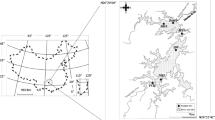Abstract
Reservoirs created for hydropower production have become an important feature impacting a river. Understanding the effects of river impoundment on the downstream environment is critical to decision-making for water resource protection. The changes caused by impoundment are changes in water quality and the resulting effect on the phytoplankton community structure. The impacts caused by a series of reservoirs along a river are still not well understood. In this study, we conducted an investigation of five reservoirs along the Maotiao River, China. We found that a series of impoundments plays a role in decreasing the phytoplankton biomass in downstream reservoirs. Within the studied area, nitrogen is not a limiting factor for phytoplankton growth. The ratio of silicon to phosphorus (Si:P) can become a major factor in the regulation of phytoplankton community structure. The Si:P ratio increased from upstream to downstream reservoirs, causing a concurrent increase in the percentage of Bacillariophyta, particularly during the winter. In addition, our results indicate that the creation of dams eliminates Si limitation downstream.





Similar content being viewed by others
References
Billen, G., & Garnier, J. (1997). The Phison River plume: Coastal eutrophication in response to changes in land use and water management in the watershed. Aquatic Microbial Ecology, 13, 3–17.
Conley, D. J., Stalnacke, P., Pitkanen, H., & Wilander, A. (2000). The transport and retention of dissolved silicate by rivers in Sweden and Finland. Limnology and Oceanography, 45, 1850–1853.
Friedl, G., & Wüest, A. (2002). Disrupting biogeochemical cycles: Consequences of damming. Aquatic Sciences, 64, 55–65.
Friedl, G., Teodoru, C., & Wehrli, B. (2004). Is the Iron Gate I reservoir on the Danube River a sink for dissolved silica? Biogeochemistry, 68, 21–32.
Hein, M., & Riemann, B. (1995). Nutrient limitation of phytoplankton biomass or growth rate: An experimental approach using marine enclosures. Journal of Experimental Marine Biology and Ecology, 188, 167–180.
Howarth, R. W., Billen, G., Chan, F., Conley, D., Doney, S. C., Garnier, J., et al. (2011). Coupled biogeochemical cycles: Eutrophication and hypoxia in coastal marine ecosystems. Frontiers in Ecology and the Environment, 9, 18–26.
Humborg, C., Ittekot, V., Cociosu, A., & Bdungen, B. V. (1997). Effect of Danube river dam on black sea biogeochemistry and ecosystem structure. Nature, 386, 385–388.
Humborg, C., Conley, D. J., Rahm, L., Wulff, F., Cociasu, A., & Ittekkot, V. (2000). Silicon retention in river basins: Far-reaching effects on biogeochemistry and aquatic food webs in coastal marine environments. Ambio, 29, 45–50.
Justic, D., Rabalais, N. N., & Turner, R. E. (1995a). Stoichiometric nutrient balance and origin of coastal eutrophication. Marine Pollution Bulletin, 30, 41–46.
Justic, D., Rabalais, N. N., Turner, R. E., & Dortch, Q. (1995b). Changes in nutrient structure of river-dominated coastal waters: Stoichiometric nutrient balance and its consequences. Estuarine, Coastal and Shelf Science, 40, 339–356.
Kelly, V. J. (2001). Influence of reservoirs on solute transport: A regional-scale approach. Hydrological Processes, 15, 1227–1249.
Koszelnik, P., & Tomaszek, J. A. (2008). Dissolved silica retention and its impact on eutrophication in a complex of mountain reservoirs. Water, Air, and Soil pollution, 189, 189–198.
Lane, R. R., Day, J. W., Justic, D., Reyes, E., Marx, B., Day, J. N., et al. (2004). Changes in stoichiometric Si, N and P ratios of Mississippi River water diverted through coastal wetlands to the Gulf of Mexico. Estuarine, Coastal and Shelf Science, 60, 1–10.
Meybeck, M. (1982). Carbon, nitrogen, and phosphorus transport by World rivers. American Journal of Science, 282, 401–450.
Muylaert, K., Sanchez-Perez, J. M., Teissier, S., Sauvage, S., Dauta, A., & Vervier, P. (2009). Eutrophication and its effect on dissolved Si concentrations in the Garonne River (France). Journal of Limnology, 68, 368–374.
Rabalais, N. N., Turner, R. E., Justic, D., Dortch, Q., Wiseman, W. J., & Sen Gupta, B. K. (1996). Nutrient changes in the Mississippi River and system responses on the adjacent continental shelf. Estuaries, 19, 386–407.
Redfield, A. C. (1958). The biological control of chemical factors in environment. American Journal of Science, 46, 205–221.
Sterner, R. W., & Elser, J. J. (2002). Ecological stoichiometry: The biology of elements from molecules to the biosphere. Princeton: Princeton University Press.
Turner, R. E., Rabalais, N. N., Justic, D., & Dortch, Q. (2003a). Global patterns of dissolved N, P and Si in Large Rivers. Biogeochemistry, 64, 297–317.
Turner, R. E., Rabalais, N. N., Justic, D., & Dortch, Q. (2003b). Future aquatic nutrient limitations. Marine Pollution Bulletin, 46, 1032–1034.
Wang, F., Yu, Y., Liu, C. Q., Wang, B., Wang, Y., Guan, J., et al. (2010). Dissolved silicate retention and transport in cascade reservoirs in Karst area, Southwest China. Science of the Total Environment, 408, 1667–1675.
Wang, F., Wang, B., Liu, C. Q., Wang, Y., Guan, J., Liu, X., et al. (2011). Carbon dioxide emission from surface water in cascade reservoirs–river system on the Maotiao River, southwest of China. Atmospheric Environment, 45, 3827–3834.
Yan, W., Yin, C., & Zhang, S. (1999). Nutrient budgets and biogeochemistry in an experimental agricultural watershed in Southeastern China. Biogeochemistry, 45, 1–19.
Zhang, Z. S., & Huang, X. F. (1991). Methods in freshwater plankton study [in Chinese]. Beijing: Science Press.
Acknowledgments
The authors thank Huihui Li, Zhiwei Han, Chipeng Zhang, Yan Yang and Ganrong Li for their careful assistances in field sampling. This research was financially supported by the National Natural Science Foundation of China (Nos. 41273128 and 41021062) and the Shanghai Municipal Education Commission (12YZ017).
Author information
Authors and Affiliations
Corresponding author
Rights and permissions
About this article
Cite this article
Wang, F., Wang, B., Liu, CQ. et al. Changes in nutrient ratios and phytoplankton community structure caused by hydropower development in the Maotiao River, China. Environ Geochem Health 36, 595–603 (2014). https://doi.org/10.1007/s10653-013-9583-2
Received:
Accepted:
Published:
Issue Date:
DOI: https://doi.org/10.1007/s10653-013-9583-2




